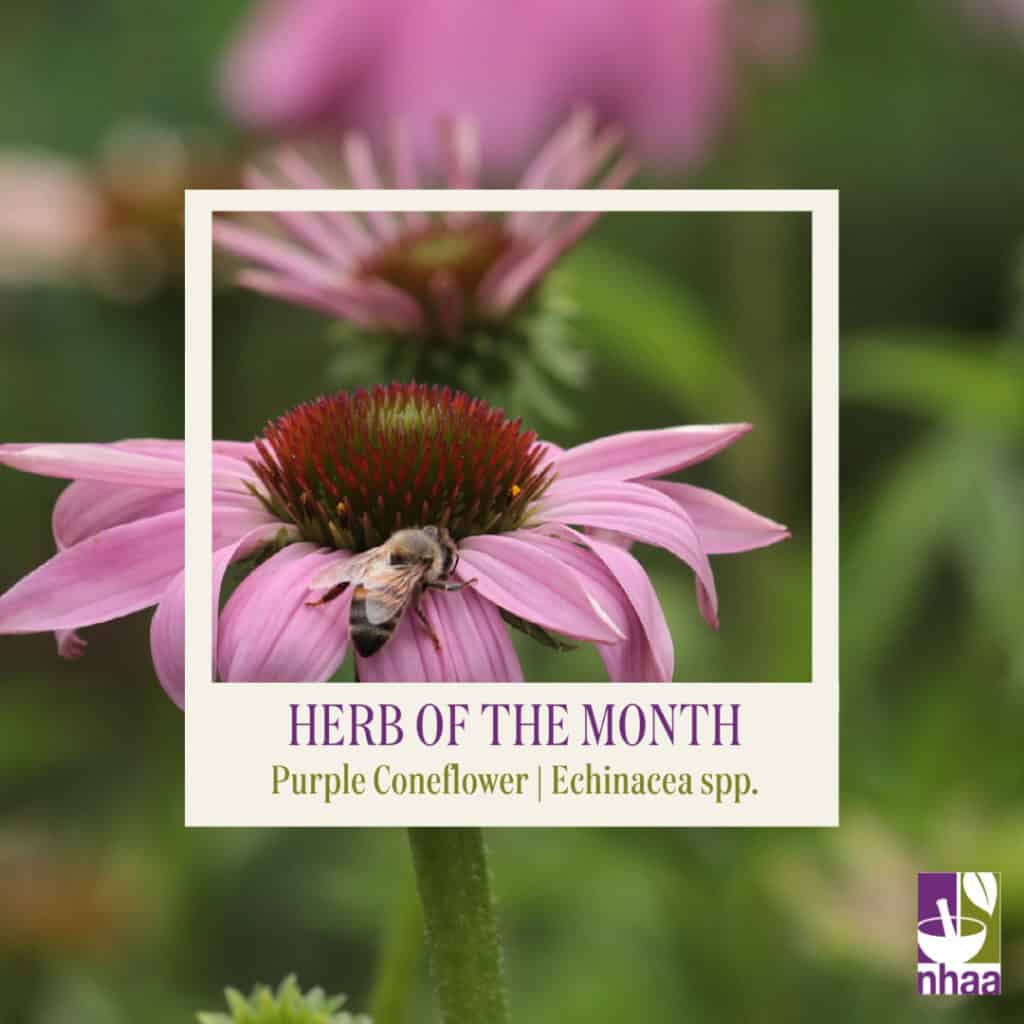
🌿 This month’s herb of the month is Purple Coneflower or Echinacea spp.
Family: Asteraceae/Compositae
🌿 Botanical name and description:
Commonly termed ‘purple coneflower’, Echinacea comprises numerous perennial plant species from the Asteraceae family including Echinacea angustifolia, Echinacea pallida, and Echinacea purpurea (Burlou-Nagy et al, 2022). Both Echinacea angustifolia and Echinacea pallida are grown from a tap root while Echinacea purpurea has a fibrous root system; all have single or branched stems with soft bristle-like hairs, basal leaves, and the symbolic prominent cone-shaped flower-head. Echinacea species are cultivated widely, albeit slow growing and without flowers for at least two or three years. The roots, due to having the highest level of the therapeutic constituent, alkylamides (Bone, 2023), are harvested following the completion of flowering and are utilized fresh or dried. The whole plant including the aerial parts are also used, depending on the species. Echinacea growing in the wild is native to barren and dry regions of North America so is drought tolerant, content in an open sunny position with soil slightly alkaline.
🌿 History and traditional uses:
A panacea for the native Americans and adopted by Europeans in the 17th century, historical uses of Echinacea included blood purification, correcting sepsis and malignancy in gangrene, ulcerations, carbuncles, boils, and various forms of septicaemia (Kings American Dispensatory, 1898). American Eclectics transitioned Echinacea to the forefront of modern herbal medicine (Kings American Dispensatory, 1898) and, thankfully, following the advent of pharmaceuticals, its use sustained. Echinacea is now revered globally and adopted by individuals and herbalists alike.
🌿 Actions and usage today:
Echinacea is generally administered orally and should cause a tingling sensation on the tongue, generating salivation. With larger doses, it is best to dilute to avoid excessive salivation. Due to its immune-modulating actions, Echinacea is utilized as a prophylaxis and treatment for ailments such as the common cold (Karsch et al, 2015;Ross, 2016). Also, due to its potent antimicrobial actions, Echinacea is effective in treating infections [fungus, parasites, virus, bacteria] of the skin, respiratory tract, GIT, urinary tract, reproductive tract, and musculoskeletal system.
Overall, Echinacea is considered very safe for use and is often well tolerated (Ross et, 2016;Weishaupt et al, 2020) with minimal adverse reactions reported; even use in pregnant women has reported no association with an increased risk of malformations or adverse pregnancy outcomes (Heitmann et al, 2016). Although, prudence always prevails…. beware in cases of known allergies to the Asteraceae family. Caution – Echinacea can inhibit CYP450 liver enzymes which may cause distorted effects with certain drugs (Gorski et al, 2004). Further, Echinacea should not be used immediately before, during, or after transplant surgery.
🌿 Science and clinical trials:
The values and versatilities of this herb are advocated by distinguished herbalists, including Professor Kerry Bone (Bone, 2023), and described in countless research articles, some exploring the biological and pharmacological properties of Echinacea (Burlou-Nagy et al, 2022) or investigating its use in the prevention or treatment of COVID and other respiratory tract infections (Aucoin et al, 2020; David, 2019).
The safety and dose-dependent effects of using Echinacea for the treatment of acute cold episodes are supported in a multicentre RCT (Weishaupt et al, 2020). Further clinical trials investigating Echinacea use identify the prevention of respiratory tract infections and the reduction of antibiotic usage in children (Ogal et al, 2021). A meta-analysis of RCTs also supports the reduction of risk of recurrent respiratory tract infections and complications when using Echinacea (Schapowal et al, 2015).
1. Burlou-Nagy C, Bănică F, Jurca T, Vicaș LG, Marian E, Muresan ME, et al. Echinacea purpurea (L.) Moench: Biological and Pharmacological Properties. A Review. Plants [Internet]. 2022; 11(9).
2. Bone K. The MediHerb Echinacea Research Story. 2023.
3. King’s American Dispensatory. Echinacea – Echinacea 1898 [Available from: https://www.henriettes-herb.com/eclectic/kings/echinacea.html.
4. Karsch-Völk M, Barrett B, Linde K. Echinacea for Preventing and Treating the Common Cold. JAMA. 2015;313(6):618-9.
5. Ross SM. Echinacea purpurea: A Proprietary Extract of: Echinacea purpurea: Is Shown to be Safe and Effective in the Prevention of the Common Cold. Holistic Nursing Practice. 2016;30(1).
6. Weishaupt R, Bächler A, Feldhaus S, Lang G, Klein P, Schoop R. Safety and Dose-Dependent Effects of Echinacea for the Treatment of Acute Cold Episodes in Children: A Multicenter, Randomized, Open-Label Clinical Trial. Children [Internet]. 2020; 7(12).
7. Heitmann K, Havnen GC, Holst L, Nordeng H. Pregnancy outcomes after prenatal exposure to echinacea: the Norwegian Mother and Child Cohort Study. Eur J Clin Pharmacol. 2016;72(5):623-30.
8. Gorski JC, Huang S-M, Pinto A, Hamman MA, Hilligoss JK, Zaheer NA, et al. The Effect of Echinacea (Echinacea purpurea Root) on Cytochrome P450 Activity in Vivo. Clinical Pharmacology & Therapeutics. 2004;75(1):89-100.
9. Aucoin M, Cooley K, Saunders PR, Carè J, Anheyer D, Medina DN, et al. The effect of Echinacea spp. on the prevention or treatment of COVID-19 and other respiratory tract infections in humans: A rapid review. Advances in Integrative Medicine. 2020;7(4):203-17.
10. David S, Cunningham R. Echinacea for the prevention and treatment of upper respiratory tract infections: A systematic review and meta-analysis. Complementary Therapies in Medicine. 2019;44:18-26.
11. Ogal M, Johnston SL, Klein P, Schoop R. Echinacea reduces antibiotic usage in children through respiratory tract infection prevention: a randomized, blinded, controlled clinical trial. European Journal of Medical Research. 2021;26(1):33.
12. Schapowal A, Klein P, Johnston SL. Echinacea Reduces the Risk of Recurrent Respiratory Tract Infections and Complications: A Meta-Analysis of Randomized Controlled Trials. Advances in Therapy. 2015;32(3):187-200.